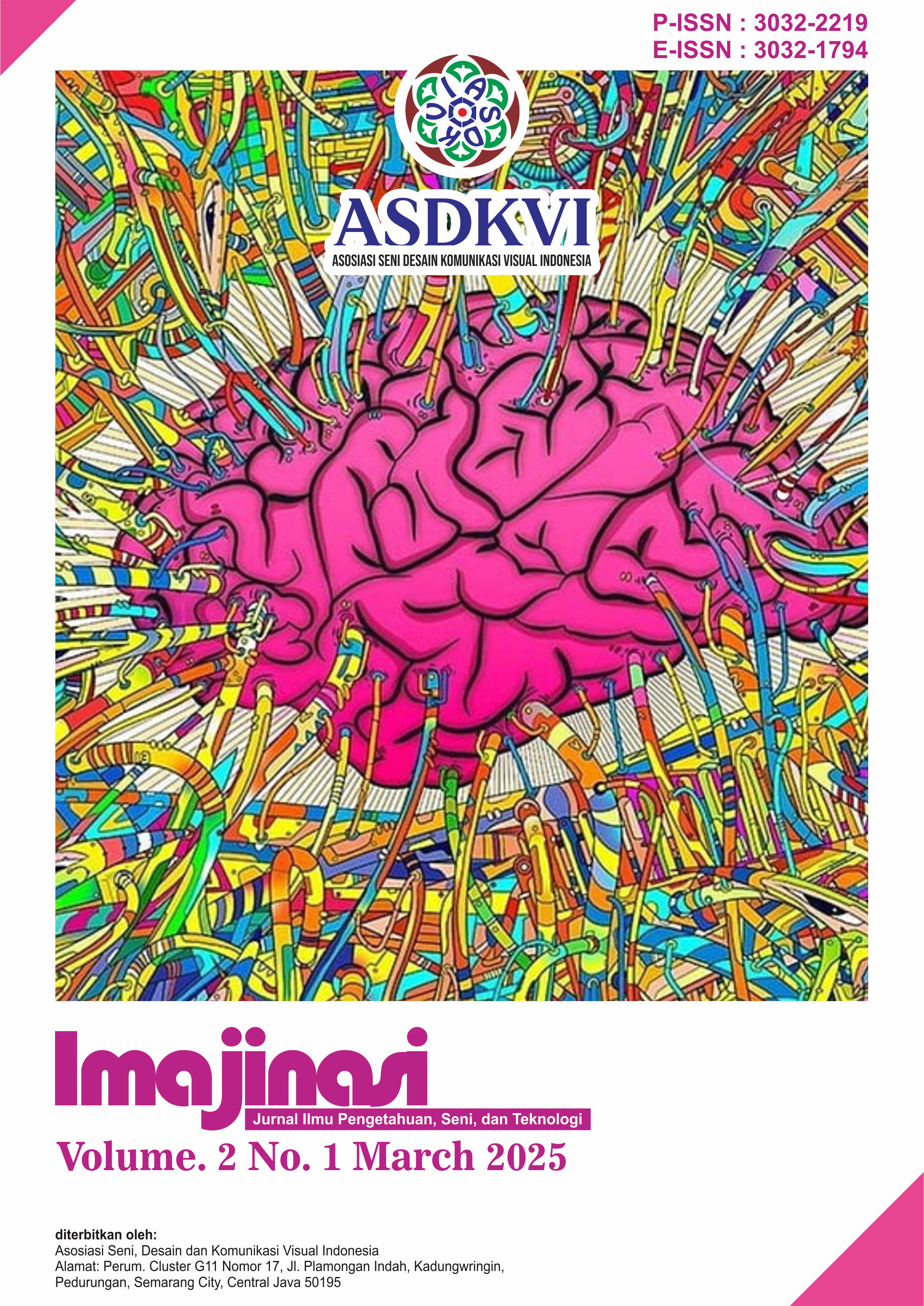Estetika Visual dan Pengaruhnya terhadap Kenyamanan Psikologis dalam Ruang
DOI:
https://doi.org/10.62383/imajinasi.v2i2.620Keywords:
Interior Design, Psychological Comfort , Space Perception, Visual AestheticsAbstract
Visual aesthetics in interior design plays an important role in shaping an individual's emotional and psychological experience in a space. A visually appealing room design can create a positive and pleasant impression. Symmetrical ratios, careful color selection, and decorative elements can evoke emotional responses and enhance the beauty of perception. This study aims to examine the relationship between visual aesthetic elements such as color, lighting, texture, and layout with the level of psychological comfort of the occupants of the space. The methods used in this study are qualitative and quantitative approaches, through observation, and interviews. The results of the study indicate that spaces with harmonious and harmonious visual aesthetics significantly increase feelings of calm, focus, and psychological comfort. Conversely, rooms with chaotic or too monotonous designs can trigger stress and discomfort. These findings emphasize the importance of the role of aesthetics in designing spaces that are not only functional, but also support the mental health and well-being of their users.
References
Darmawan, A. L., & Avenzoar, A. (2023). Pengaruh Penggunaan Warna Ruang Terhadap. 20(1), 15–21.
Kanaya, A. (2024). Perancangan Wellness Center Di Kota Yogyakarta Dengan Pendekatan Psikologi Lingkungan (Doctoral dissertation, UNIVERSITAS ATMA JAYA YOGYAKARTA).
Kumala, K. I., & Arsandrie, Y. (2021). Kenyamanan Psikologis Pada Desain Interior Fasilitas Kebidanan. Siar Ii 2021: Seminar Ilmiah Arsitektur, 8686, 591–598.
Made, N., Indrayati, S., & Darmayanti, T. E. (2024). Pengaruh Tata Ruang Terhadap Kenyamanan Penghuni : Daerah Babakan Jeruk dan Sukakarya Bandung. 12(2), 67–78.
Nadaa, Z. (2017). Pengaruh Desain Interior Pada Faktor Kenyamanan Pasien Diruang Tunggu Unit Rawat Jalan Rumah Sakit. Jurnal Desain & Seni, FDSK - UMB |, 4(3), 239–257. http://publikasi.mercubuana.ac.id/index.php/narada/article/view/3223/1776
Nugroho, A. M., & Iyati, W. (2021). Arsitektur Bioklimatik: Inovasi Sains Arsitektur Negeri untuk Kenyamanan Termal Alami Bangunan. Universitas Brawijaya Press.
Pokhrel, S. (2024). No TitleΕΛΕΝΗ. Αγαη, 15(1), 37–48.
Ramadhani, I. (2016). Keterkaitan Elemen Interior Tempat Makan Terhadap Sosial Masyarakat. Jurnal Proporsi, 1(2).
Redjeki, S. (2022). Konsep Estetika Tauhid Pada Arsitektur Islam (Studi Pemikiran Seyyed Hossein Nasr Dalam Tafsir The Study Quran: A New Translation And Commentary) (Doctoral dissertation, Institut PTIQ Jakarta).
Revy, A., Gani, A. C., & Effendi, A. C. (2024). Efek Warna terhadap Kenyamanan Visual pada Interior Perpustakaan dalam Meningkatkan Produktivitas Pengunjung. 12(1), 1–7.
Rubiyanti, Y. (2023). Tinjauan Sistematis Mengenai Pengaruh Desain Interior Pada Kesejahteraan Jiwa Pengguna Ruang. Prosiding Seminar Nasional Manajemen, Desain & Aplikasi Bisnis Teknologi (SENADA), 6(1), 1–11. http://senada.idbbali.ac.id
Rusdy, M. K. (2021). Perancangan taman ekologi (Eco Park) di Waduk Telaga Bunder Gresik dengan pendekatan bioklimatik (Doctoral dissertation, Universitas Islam Negeri Maulana Malik Ibrahim).
Sachari, A. (2007). Budaya Visual Indonesia: membaca makna perkembangan gaya visual karya desain di Indonesia abad ke-20. Erlangga.
Satwiko, P. (2024). Desain Ramah Otak. Salsabila, A. A. (2022). Perancangan Creative Hub dengan Pendekatan Kenyamanan dan Kesehatan Ruang di Kota Tasikmalaya (Doctoral dissertation, Universitas Islam Indonesia).
Sutanto, A. (2020). Peta Metode Desain. Jakarta: Universitas Tarumanagara, 227.
Ulyana, F., Levandani, A. A., Islam, U., Walisongo, N., Islam, U., & Walisongo, N. (2025). Arsitektur Berbasis Kesehatan Mental : Menciptakan Ruang yang Mendukung Kesehatan Emosional Universitas Islam Negeri Walisongo Semarang , Indonesia Alamat : Semarang , Indonesia diantaranya yaitu Kasus di Bekasi ( 2024 ) Seorang ibu berinisial SNF membunuh anaknya yang. 84–102.
Umaroh, N., Palwono, M. A., Al-farizi, M. H., & Mahardika, P. (2024). PENGARUH TATA RUANG TERHADAP PERSONAL SPACE DI. Ummah, M. S. (2019). No 主観的健康感を中心とした在宅高齢者における 健康関連指標に関する共分散構造分析Title. Sustainability (Switzerland), 11(1), 1–14. http://scioteca.caf.com/bitstream/handle/123456789/1091/RED2017-Eng-8ene.pdf?sequence=12&isAllowed=y%0Ahttp://dx.doi.org/10.1016/j.regsciurbeco.2008.06.005%0Ahttps://www.researchgate.net/publication/305320484_SISTEM_PEMBETUNGAN_TERPUSAT_STRATEGI_MELESTARI
Vedri Rahmadhana, & Heldi Heldi. (2023). Hubungan Desain Interior Terhadap Kenyamanan Pemustaka Di Dinas Kearsipan Dan Perpustakaan Provinsi Sumatera Barat. Atmosfer: Jurnal Pendidikan, Bahasa, Sastra, Seni, Budaya, Dan Sosial Humaniora, 1(4), 206–215. https://doi.org/10.59024/atmosfer.v1i4.371
Wardani, V. A. K. (2022). Perancangan Resort Dengan Pendekatan Arsitektur Biofi Lik Di Kulon Progo Yogyakarta.
Wasista, P. U., Giri, K. R. P., Artadi, I. M. P., Kerdiati, N. L. K. R., Trisna, N. M. S. W., Darmastuti, P. A., ... & Putra, P. S. U. (2024). Desain Interior: Teori dan Perkembangannya. SIDYANUSA.
Downloads
Published
How to Cite
Issue
Section
License
Copyright (c) 2025 Imajinasi : Jurnal Ilmu Pengetahuan, Seni, dan Teknologi

This work is licensed under a Creative Commons Attribution-ShareAlike 4.0 International License.





